Woodwind Ensemble,Woodwind Quartet Bassoon,Clarinet,Flute,Oboe - Level 3 - Digital Download SKU: A0.1425964 Composed by Ludwig van Beethoven. Arranged by SCMusic. 19th Century,Classical,Romantic Period,Traditional. 14 pages. SCMusic #1006753. Published by SCMusic (A0.1425964). A medley of Beethoven's well-known pieces arranged for woodwind quartet, including melodies from Für Elise, Moonlight Sonata, Pathetique Sonata, Ode to Joy and 5th & 7th Symphonies. Separate instrumental parts included in print out.
